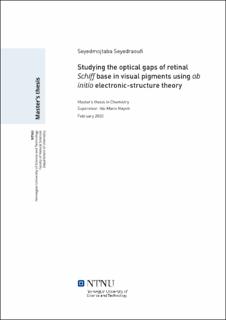| dc.contributor.advisor | Høyvik, Ida-Marie | |
| dc.contributor.author | Seyedraoufi, Seyedmojtaba | |
| dc.date.accessioned | 2020-06-04T16:01:13Z | |
| dc.date.available | 2020-06-04T16:01:13Z | |
| dc.date.issued | 2020 | |
| dc.identifier.uri | https://hdl.handle.net/11250/2656658 | |
| dc.description.abstract | Netthinnen, som er et tynt lag med celler på baksiden av øyeeplet, inneholder to viktige typer proteiner, tapp- og stav-synspigmentene. Stav-synspigmenter eller rhodopsin er ansvarlig for synet i lav lysintensitet, og tapp-pigmenter, som består av røde, grønne og blå tapper, er ansvarlige for synet i dagslys. De inneholder alle retinal Schiff-base som kromofor omgitt av et protein som innstiller absorpsjonsspekteret fra 365-430 nm til 498 nm for rhodopsin og 425 nm for blå tapper. En rekke studier, fra spektroskopiske undersøkelser til teoretiske studier, er rettet mot å avdekke proteinmiljøets rolle i dette signifikante absorpsjonsskiftet. Elektrostatisk effekt av protein-residues, og enda vik tigere det antatte motionet av Schiff-basen, og fordreining av retinen påført av proteinet, er vidt aksepterte mekanismer som hittil er gitt. Ved å bruke coupled cluster med tilnærmet singles og doubles-metoden og resolution of identity-tilnærming (RICC2) som ab initio-metode sammen med tetthetsfunksjonalteori, har vi studert videre den mulige rollen residues spiller i absorpsjonsskiftet, til sammenligning med motionets rolle. Vår undersøkelse bekrefter den viktige rollen Glu-113 spiller i rhodopsin-absorpsjon. I blå tapper instilles derimot absorpsjonsspekteret ved deprotonering av Schiff-basen og en gruppe residues. Vi undersøker også effekten av forskjellige protoneringstilstander av Glu-181 og Glu-178 i henholdsvis rhodopsin og blå tappers absorpsjon. Vi konkluderer med at et negativt ladet glutamat kan forstyrre effektiviteten av fotoisomerisering i begge pigmenter. Til slutt undersøker vi protonaffiniteten til Schiff-basen i både rhodopsin og blå tapper. | |
| dc.description.abstract | Retina, which is a thin layer of cells in the back of the eyeball, contains two important types of proteins, cone and rod visual pigments. Rod visual pigment or rhodopsin is responsible for vision in low light intensity and cone pigments, consisting of red, green, and blue cones, are responsible for day-light vision. All of them contain retinal Schiff base as the chromophore and a surrounding protein which tunes the absorption spectrum from 365-430 nm to 498 nm for rhodopsin and 425 nm for the blue cone. Numerous studies, from spectroscopic investigations to theoretical studies are devoted to unravel the protein environment role in this significant absorption shift. The electrostatic effect of residues, more importantly, the putative counterion of the Schiff base, and distortion of the retinal imposed by the protein are well-accepted mechanisms so far provided. Using coupled cluster with approximate singles and doubles method and the resolution of identity approximation (RICC2) as an ab initio method together with density functional theory allowed us to dig more into the possible role of protein residues in the shifting of the absorption spectrum, as compared to the role of the counterion. Our investigation confirms the important role of Glu-113 in rhodopsin absorption. Conversely, in the blue cone, deprotonation of the Schiff base and group of residues tune the absorption spectrum. We also investigate the effect of different protonation states of Glu-181 and Glu-178 in rhodopsin and blue cone absorption respectively. We conclude that a negatively charged glutamate might disrupt the efficiency of photoisomerization in both pigments. Finally, we investigate the proton affinity of the Schiff base in both rhodopsin and blue cone. | |
| dc.language | eng | |
| dc.publisher | NTNU | |
| dc.title | Studying the optical gaps of retinal Schiff base in visual pigments using ab initio electronic-structure theory | |
| dc.type | Master thesis | |
